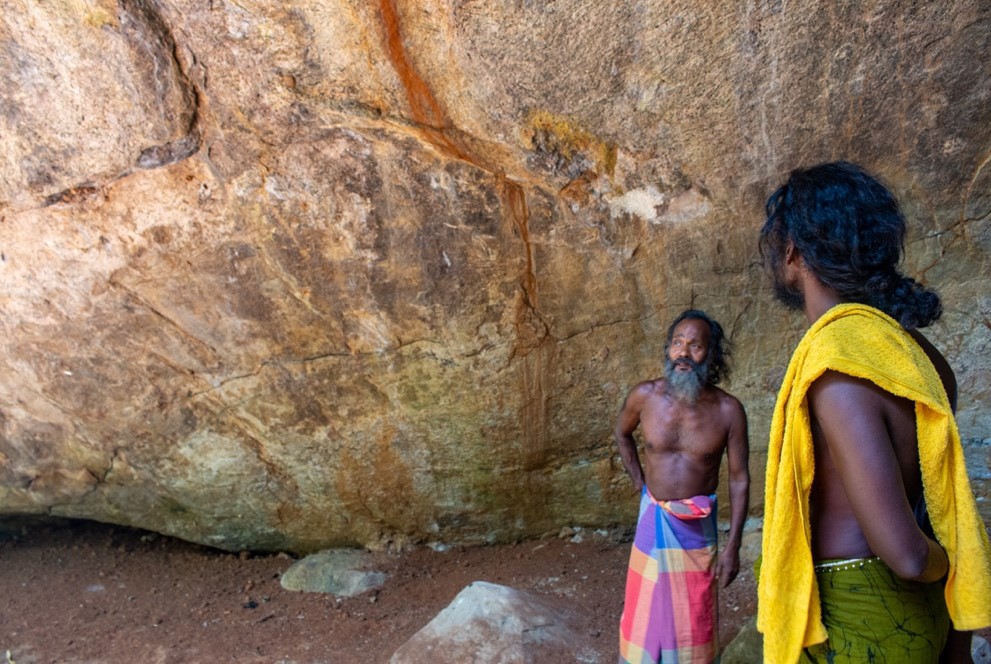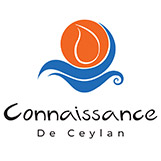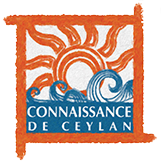(The Chief and Gunabandal Atho) Copyrights Connaissance De Ceylan)
Sri Lanka’s first people the Vedda or Adivasi have a captivating story. According to the islands fascinating historical chronicle - the Mahavamsa, it is said that they were the children or descendants of Queen Kuveni, a Yaksha and the wife of Sri Lanka’s legendary first King Vijay (5th BC). However, according to anthropologists, their origins are much older; with some anthropologists dating them back to the stone age.
A hunter-gather people, the Veddas have a long history of living harmoniously with nature. There are three predominant types of Veddas- Gal Veddas or cave-dwelling, who spent their time in forest caves; Muhudu Veddas or Coastal Veddas, that lived on the coastline; and Gam Veddas or village Veddas, that lived off in Chena Cultivation in small huts in village communities.
(A cave formerly inhabited by their ancestors) (The replica village at their cultural centre) Copyrights Connaissance De Ceylan
Recently, we were lucky enough to go to Rathugala close to Gal Oya National Park to meet the Adivasi community and have a great discussion with them on their past, present and future.
A unique culture and way of life.
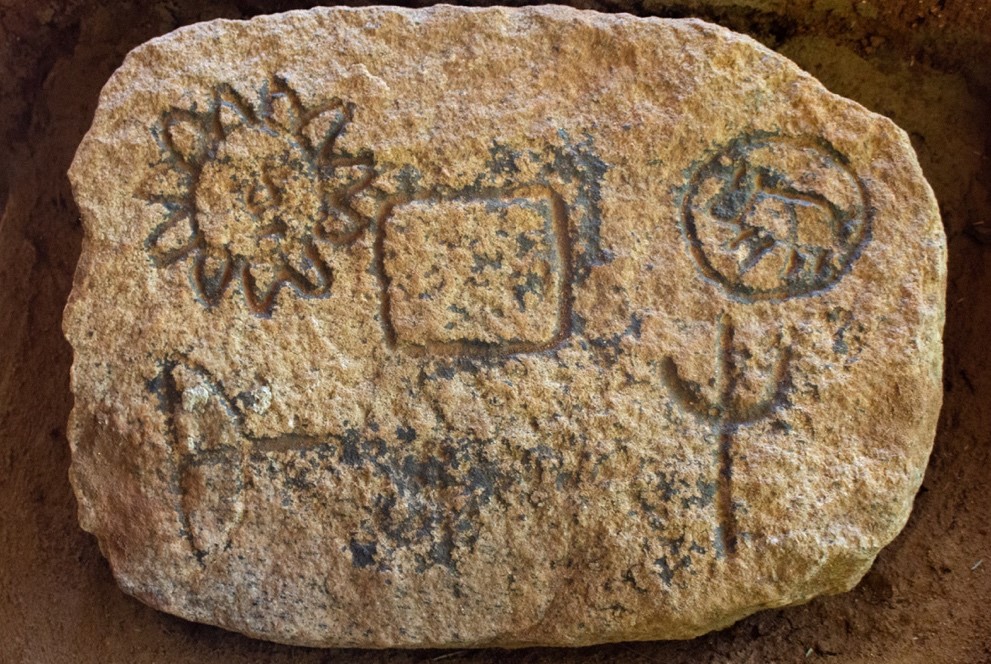 (Ancient inscriptions from the Veddas) Copyrights Connaissance De Ceylan
(Ancient inscriptions from the Veddas) Copyrights Connaissance De Ceylan
We met our hosts, the chief of the Rathugala Veddas and his deputy, Gunabandal Atho, at a newly built Cultural Center which aims to showcase their way of life and traditions. Walking around the centre, Chief explained to us their techniques of hunting using a mixture of traps, bow & arrow to gather meat for their community usually in the form of Deer, Wild Boar and Rabbits found in the dense jungles in the vicinity.
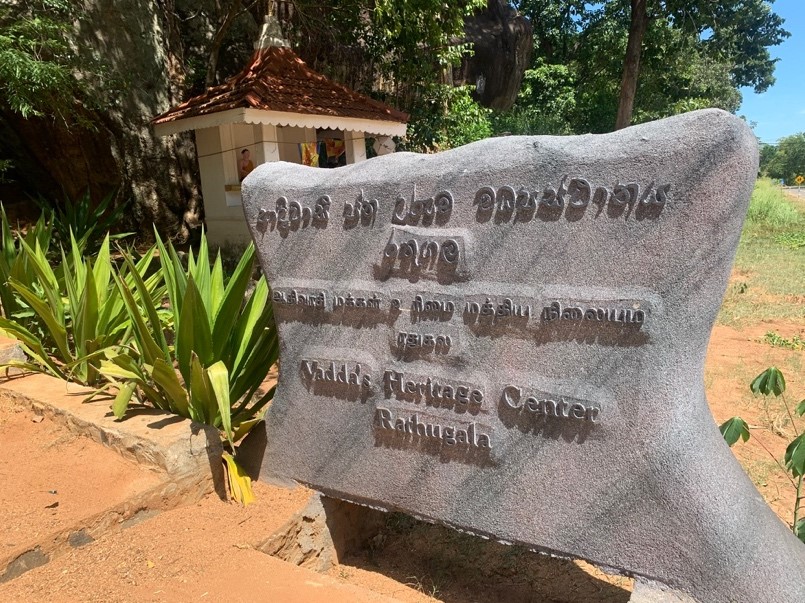 (The Heritage Center) Copyrights Connaissance De Ceylan
(The Heritage Center) Copyrights Connaissance De Ceylan
Another unique and quite famous practice of Vedda’s is their collection of bee’s honey, “Karadha Thaniga”. Gunabandal Atho described to us their expeditions deep into the forest to find beehives. Once found, explained how they would collect honey by climbing trees up to the hives warding off the bees by burning dry leaves. Amazed at this practice, we asked them what happens if they got stung? They chuckled saying that it did not bother them in the slightest. Besides this, the Veddas have their beautiful songs and dances which accompany many of their rituals and rich traditions.
How things have changed over the years.
Over the years, many things have changed and evolved within these communities. The forest-dwelling Veddas have almost all moved into villages, mixing with other Sri Lankans, participating in normal economic activities and even intermarrying in several cases.
The chief tells us with fondness about his old homes in the caves of the thick forest of Dahnigala and how they ended in the village of Rathugala. He says that beginning in the early 1950s, a part of his community was relocated due to the construction of a massive manmade reservoir, the Senanayake Samudhraya. This reservoir was built to irrigate the arid farmlands of the East and South East of the country to feed the countries growing population. It certainly has brought great prosperity to the region as well as created a thriving environment for elephants in the form of the Gal Oya National Park today. Over the following years, the rest of the communities moved into the village for many reasons which include a ban on hunting and increased restrictions.
However, the communities have not lost all connection with the forests. They often venture over multiple days into the forests to collect honey. Chatting about the forests, we get a true sense of their love for the forest that fed and nurtured them for generations. The chief tells us that through the years he has fought countless times to stop deforestation and protect the forests from illicit felling for timber as well cultivation. He sadly tells us that over the years, he has seen a big loss of diversity in the forests with many species he commonly found like deer and pangolins being harder and harder to find now in present.
Today, the Veddas make a living by selling honey, beedi leaves (a leaf used to wrap a local cigarette) and by doing odd jobs. With limited opportunities, the chief tells us that many of the younger members of the clan are leaving to the big cities to find better financial prospects leaving their communities and culture behind.
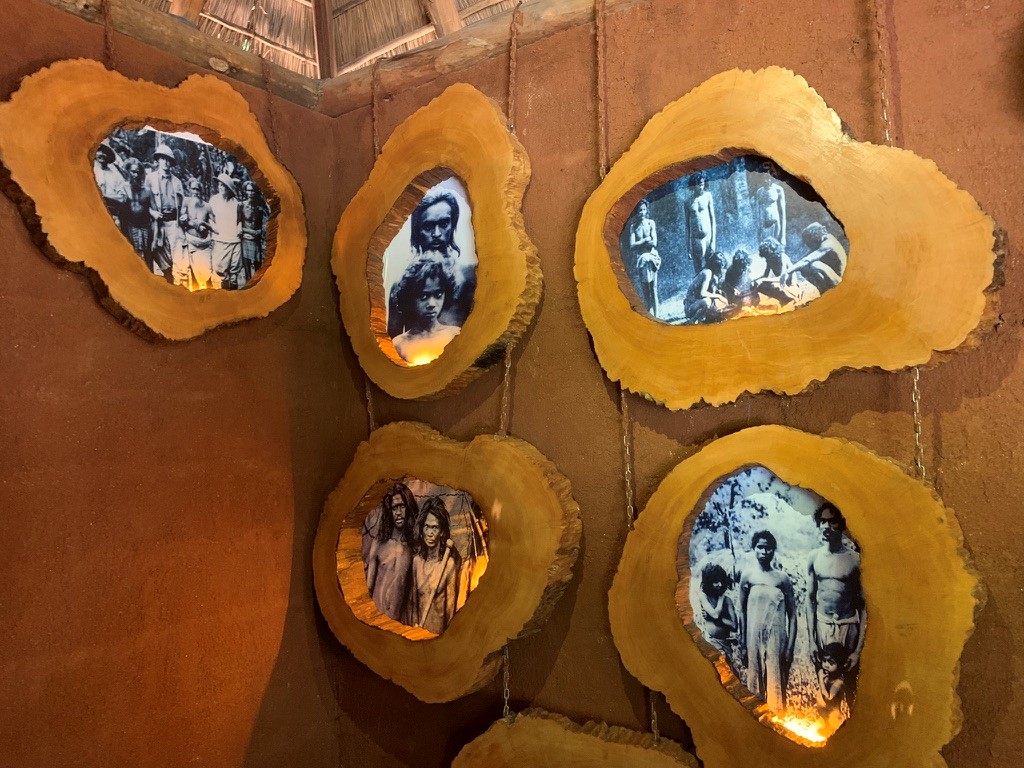 (First ever photographs of their community) Copyrights Connaissance De Ceylan
(First ever photographs of their community) Copyrights Connaissance De Ceylan
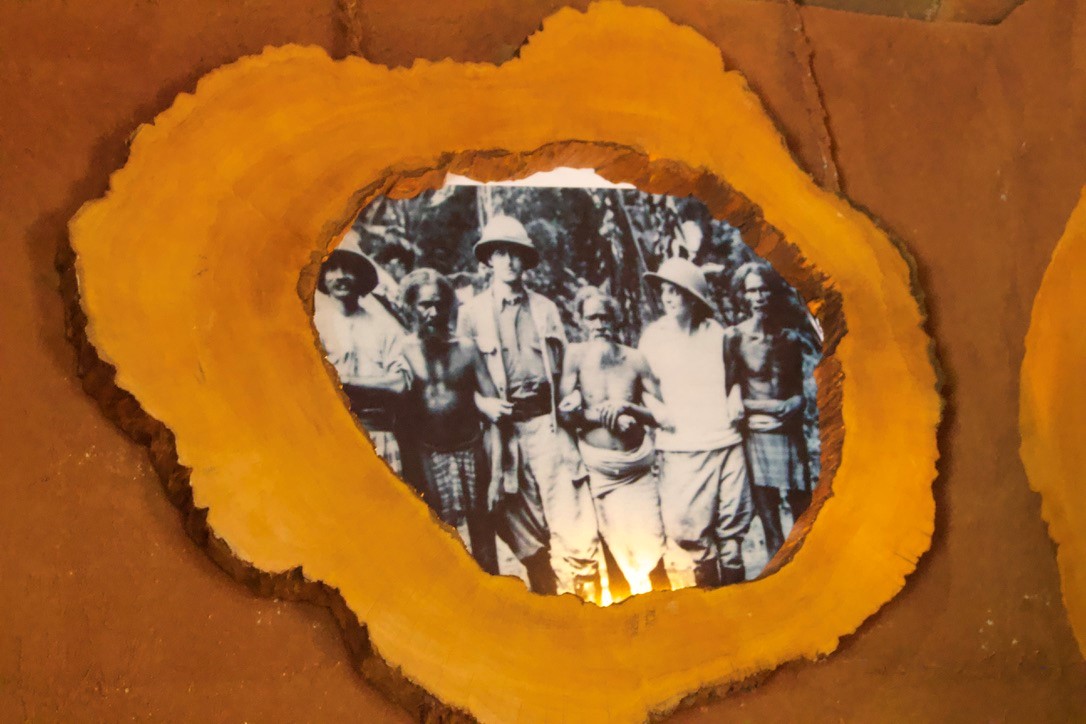 The future and preserving a culture.
The future and preserving a culture.
The chief fears that his culture and language is at risk with the migration of younger generations and lack of opportunities for work around his region. Nevertheless, he remains optimistic that through ethical tourism-related activities they will be able to protect their culture, language and way of life with sustained income which would promote their ways of living.
This is a sentiment we can’t help but agree with. Over the coming years, our team will look to promote tourism in the region to provide opportunities for work as well as showcase their culture and traditions in an ethical and dignified manner.
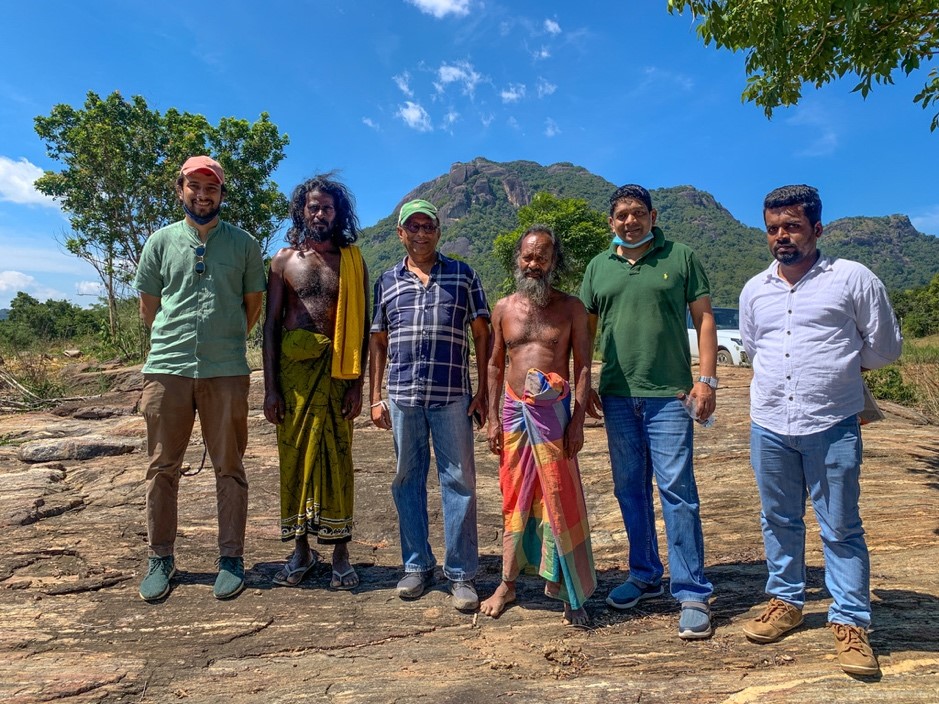 Maxime, Gunabandal Atho, Chandra, The Chief, Chamin and Asanka.
How to visit
Maxime, Gunabandal Atho, Chandra, The Chief, Chamin and Asanka.
How to visit
If you are interested in visiting the Veddas, we recommend spending a few nights in Gal Oya or Mahiyanganaya to visit the communities around these regions and discover hunting techniques and other survival methods they used.
Also, both locations offer truly off the beaten track safari experiences with Maduru Oya National Park close to Mahiyanganaya and, of course, the famed Gal Oya National Park as well. Here you will miss the rush of heavy crowds as witnessed in more popular national parks and experience a truly private and exclusive experience.
If interested, do speak to our team for other activities and more information about your visit to the area.
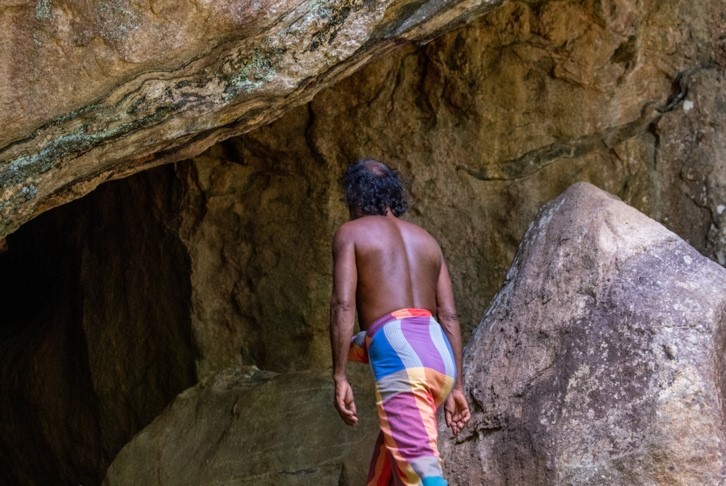
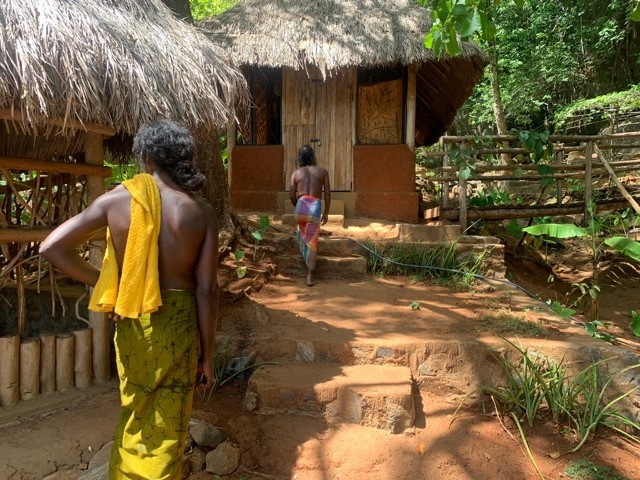
 (Ancient inscriptions from the Veddas) Copyrights Connaissance De Ceylan
We met our hosts, the chief of the Rathugala Veddas and his deputy, Gunabandal Atho, at a newly built Cultural Center which aims to showcase their way of life and traditions. Walking around the centre, Chief explained to us their techniques of hunting using a mixture of traps, bow & arrow to gather meat for their community usually in the form of Deer, Wild Boar and Rabbits found in the dense jungles in the vicinity.
(Ancient inscriptions from the Veddas) Copyrights Connaissance De Ceylan
We met our hosts, the chief of the Rathugala Veddas and his deputy, Gunabandal Atho, at a newly built Cultural Center which aims to showcase their way of life and traditions. Walking around the centre, Chief explained to us their techniques of hunting using a mixture of traps, bow & arrow to gather meat for their community usually in the form of Deer, Wild Boar and Rabbits found in the dense jungles in the vicinity.
 (The Heritage Center) Copyrights Connaissance De Ceylan
Another unique and quite famous practice of Vedda’s is their collection of bee’s honey, “Karadha Thaniga”. Gunabandal Atho described to us their expeditions deep into the forest to find beehives. Once found, explained how they would collect honey by climbing trees up to the hives warding off the bees by burning dry leaves. Amazed at this practice, we asked them what happens if they got stung? They chuckled saying that it did not bother them in the slightest. Besides this, the Veddas have their beautiful songs and dances which accompany many of their rituals and rich traditions.
How things have changed over the years.
Over the years, many things have changed and evolved within these communities. The forest-dwelling Veddas have almost all moved into villages, mixing with other Sri Lankans, participating in normal economic activities and even intermarrying in several cases.
The chief tells us with fondness about his old homes in the caves of the thick forest of Dahnigala and how they ended in the village of Rathugala. He says that beginning in the early 1950s, a part of his community was relocated due to the construction of a massive manmade reservoir, the Senanayake Samudhraya. This reservoir was built to irrigate the arid farmlands of the East and South East of the country to feed the countries growing population. It certainly has brought great prosperity to the region as well as created a thriving environment for elephants in the form of the Gal Oya National Park today. Over the following years, the rest of the communities moved into the village for many reasons which include a ban on hunting and increased restrictions.
However, the communities have not lost all connection with the forests. They often venture over multiple days into the forests to collect honey. Chatting about the forests, we get a true sense of their love for the forest that fed and nurtured them for generations. The chief tells us that through the years he has fought countless times to stop deforestation and protect the forests from illicit felling for timber as well cultivation. He sadly tells us that over the years, he has seen a big loss of diversity in the forests with many species he commonly found like deer and pangolins being harder and harder to find now in present.
Today, the Veddas make a living by selling honey, beedi leaves (a leaf used to wrap a local cigarette) and by doing odd jobs. With limited opportunities, the chief tells us that many of the younger members of the clan are leaving to the big cities to find better financial prospects leaving their communities and culture behind.
(The Heritage Center) Copyrights Connaissance De Ceylan
Another unique and quite famous practice of Vedda’s is their collection of bee’s honey, “Karadha Thaniga”. Gunabandal Atho described to us their expeditions deep into the forest to find beehives. Once found, explained how they would collect honey by climbing trees up to the hives warding off the bees by burning dry leaves. Amazed at this practice, we asked them what happens if they got stung? They chuckled saying that it did not bother them in the slightest. Besides this, the Veddas have their beautiful songs and dances which accompany many of their rituals and rich traditions.
How things have changed over the years.
Over the years, many things have changed and evolved within these communities. The forest-dwelling Veddas have almost all moved into villages, mixing with other Sri Lankans, participating in normal economic activities and even intermarrying in several cases.
The chief tells us with fondness about his old homes in the caves of the thick forest of Dahnigala and how they ended in the village of Rathugala. He says that beginning in the early 1950s, a part of his community was relocated due to the construction of a massive manmade reservoir, the Senanayake Samudhraya. This reservoir was built to irrigate the arid farmlands of the East and South East of the country to feed the countries growing population. It certainly has brought great prosperity to the region as well as created a thriving environment for elephants in the form of the Gal Oya National Park today. Over the following years, the rest of the communities moved into the village for many reasons which include a ban on hunting and increased restrictions.
However, the communities have not lost all connection with the forests. They often venture over multiple days into the forests to collect honey. Chatting about the forests, we get a true sense of their love for the forest that fed and nurtured them for generations. The chief tells us that through the years he has fought countless times to stop deforestation and protect the forests from illicit felling for timber as well cultivation. He sadly tells us that over the years, he has seen a big loss of diversity in the forests with many species he commonly found like deer and pangolins being harder and harder to find now in present.
Today, the Veddas make a living by selling honey, beedi leaves (a leaf used to wrap a local cigarette) and by doing odd jobs. With limited opportunities, the chief tells us that many of the younger members of the clan are leaving to the big cities to find better financial prospects leaving their communities and culture behind.
 (First ever photographs of their community) Copyrights Connaissance De Ceylan
(First ever photographs of their community) Copyrights Connaissance De Ceylan
 The future and preserving a culture.
The chief fears that his culture and language is at risk with the migration of younger generations and lack of opportunities for work around his region. Nevertheless, he remains optimistic that through ethical tourism-related activities they will be able to protect their culture, language and way of life with sustained income which would promote their ways of living.
This is a sentiment we can’t help but agree with. Over the coming years, our team will look to promote tourism in the region to provide opportunities for work as well as showcase their culture and traditions in an ethical and dignified manner.
The future and preserving a culture.
The chief fears that his culture and language is at risk with the migration of younger generations and lack of opportunities for work around his region. Nevertheless, he remains optimistic that through ethical tourism-related activities they will be able to protect their culture, language and way of life with sustained income which would promote their ways of living.
This is a sentiment we can’t help but agree with. Over the coming years, our team will look to promote tourism in the region to provide opportunities for work as well as showcase their culture and traditions in an ethical and dignified manner.
 Maxime, Gunabandal Atho, Chandra, The Chief, Chamin and Asanka.
How to visit
If you are interested in visiting the Veddas, we recommend spending a few nights in Gal Oya or Mahiyanganaya to visit the communities around these regions and discover hunting techniques and other survival methods they used.
Also, both locations offer truly off the beaten track safari experiences with Maduru Oya National Park close to Mahiyanganaya and, of course, the famed Gal Oya National Park as well. Here you will miss the rush of heavy crowds as witnessed in more popular national parks and experience a truly private and exclusive experience.
If interested, do speak to our team for other activities and more information about your visit to the area.
Maxime, Gunabandal Atho, Chandra, The Chief, Chamin and Asanka.
How to visit
If you are interested in visiting the Veddas, we recommend spending a few nights in Gal Oya or Mahiyanganaya to visit the communities around these regions and discover hunting techniques and other survival methods they used.
Also, both locations offer truly off the beaten track safari experiences with Maduru Oya National Park close to Mahiyanganaya and, of course, the famed Gal Oya National Park as well. Here you will miss the rush of heavy crowds as witnessed in more popular national parks and experience a truly private and exclusive experience.
If interested, do speak to our team for other activities and more information about your visit to the area.

